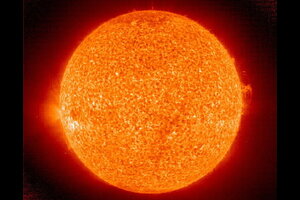What's going on with the sun? Scientists puzzled by oddities in sunspot cycle.
Even though sun-watchers have recently gotten the tools to dig deep into the underlying mechanisms driving sunspot cycles, it’s still been hard to understand Earth’s host star.

This image of the sun was taken on July 24, 2007, when it was almost spotless, a sign that the Sun may have reached solar minimum. The 11 year long solar cycle is marked by two extremes, solar minimum and solar maximum. During solar minimum, sunspot and solar flare activity diminishes, and often does not occur for days at a time.
NASA/AP
The sun has been acting strangely of late, prompting some solar physicists to suggest that once current sunspot activity peaked, which appeared to happen last fall, it could tank and remain that way for several decades.
A prolonged period with few or no spots would have a slight, temporary cooling effect on Earth's climate and a general calming effect on space weather, which would be good news for astronauts and satellites.
Recent observations of the sun show that, yes, it's still acting in a peculiar way for this point in its 11-year sunspot cycle.
But as cautious as scientists were in 2009, when they first raised the possibility of a looming so-called grand minimum, those earlier suggestions have given way to shrugs of "who knows?"
It's not for lack of trying to understand Earth's host star, say solar physicists attending the June meeting of the American Astronomical Society in Boston. But it's been hard. Some of the evidence that researchers pointed to in suggesting the coming of a grand minimum has vanished. Also, only in the past four years have sun-watchers had the tools to dig deep into the underlying mechanisms driving sunspot cycles.
And if one looks far enough into the past, at least one solar maximum in the past 100 years has been as lackluster as the current one.
If a prolonged dearth of sunspots lies ahead, researchers would be hard pressed to predict it because they don't know what the run-up to a grand minimum looks like. None of the tools in space or on Earth today were available between the mid-1600s and the early 1700s, when the sun went through the Maunder Minimum.
"At some point, we want to be able to predict what the next cycle is like," said Sarbani Basu, a Yale University astrophysicist, during a briefing Tuesday on the sun's behavior. "We're working hard; we're not there yet."
Still, given the current stage in what's known as Cycle 24, the sun is presenting researchers with some puzzling observations.
Exhibit A: Missing features in the east-to-west flow of the sun's plasma. The flow is fastest at the sun's equator and slows toward the poles, explained Rick Bogart, a solar physicist at Stanford University in California.
When the flows are mapped over the course of a sunspot cycle across the northern and southern hemispheres, they form a flying-wedge pattern that starts at the poles and whose legs, or jets, are swept away at an increasing pace until the northern and southern jets meet at the equator to form the wedge's pointed end. As these flows approach the equator, sunspots appear on their edges.
Based on previous cycles, flow patterns at each pole that in effect anchor the ends of the wedge should have started to appear around 2010, culminating in a sunspot peak around 2023 or 2024. These polar patterns have been AWOL.
Exhibit B: Near the sun's poles, temperature variations in the sun's extended atmosphere, or corona, aren't behaving as they have during past solar cycles, added Richard Altrock, with the Air Force Research Laboratory.
During a sunspot minimum, the corona's temperature near the poles cools about 1 million degrees or so simultaneously in the northern and southern hemispheres. But coming out of the last solar minimum, the northern hemisphere warmed faster than the southern hemisphere. Moreover, at the high point of Cycle 24, the corona's maximum temperature was significantly lower than during previous high points in sunspot activity, Dr. Altrock explained.
Finally, hints are cropping up in measurements of solar activity involving the most powerful outbursts from the sun, coronal mass ejections (CMEs). During the current sunspot cycle, they appear to have been erupting less often as the number of sunspots increased. Typically, CME outbursts become more frequent as the number of sunspots increases.
What to make of this is unclear, Dr. Basu of Yale said. Are these truly peculiar, or do they merely fall outside of observational experience?
Scientists have been counting and recording sunspot activity for 400 years. But only in the past 40 to 60 years have the variety of measurements increased, and only during the past four have researchers had access to continuous, highly detailed information about the regions of the sun where much of the action takes place.
"This solar cycle may not be strange in the grand scheme of things," Basu said. "Our biggest problem is that we only have good data for maybe 60 years, and the sun is a 4.5-billion-year-old star. It's too early to panic about how the sun is changing."

